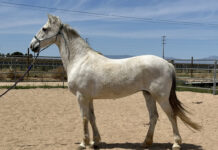 |
| Bald spots caused by tail rubbing are a possible sign of pinworm infestation. Photo: Leslie Potter |
Horses, by virtue of eating off the ground, are exposed to parasite larvae that can affect your horse’s internal health. Clinical signs range from lack of energy or poor performance to diarrhea or colic with potential surgical or fatal consequences. While at least 150 different species of internal parasites may infect horses, the main concerns focus on bloodworms, small strongyles, roundworms, and tapeworms.
Two other forms of large strongyles follow different migratory paths: Strongylus edentatus migrates through the lining of the intestinal tract (peritoneum) while Strongylus equinus journeys through the liver and pancreas. Inflammation set off in these organs can lead to an unthrifty condition or colic.
Small strongyles, also called cyasthostomes, are the current largest health concern related to intestinal parasites. These larvae invade a horse’s large intestines, encapsulating within the lining of the bowel in arrested development lasting up to two years. As these larvae mature and emerge from the bowel lining into the intestinal lumen (space), they create physical damage and focal inflammation of the bowel. When large numbers (several thousand) of larvae emerge at the same time, synchronous damage compromises a horse’s health – this is referred to as larval cyasthostomiasis. Clinical signs include diarrhea, sudden weight loss, poor growth, anemia, low blood protein, and/or colic.
Ascarid worms (roundworms) are of concern mostly in horses younger than 18 months. Heavy infestation is evident by an unthrifty, pot-bellied appearance and rough hair coat. Significant health problems include weight loss, poor growth, lack of energy, and colic. Respiratory problems (fever, cough, nasal discharge, or pneumonia) may be triggered as they migrate through the lungs on their journey to the intestinal tract.
Caution must be taken when deworming a horse with a heavy Ascarid load – worm death from the dewormer can create serious mechanical blockage within the small intestines.
 |
| Botfly eggs are tiny, yellow specs that show up on a horse’s legs, chest and belly area. If ingested, they will develop into larvae in the horse’s digestive system. |
Tapeworm-infected horses are eight times more likely to develop spasmodic colic than uninfected horses. Tapeworms may cause motility derangements due to inflammation and disruptions to nerve conduction in the bowel – this can lead to ileal impaction, small intestinal rupture, or telescoping of the bowel within itself (intussusception).
Botfly eggs develop into bot larvae, which colonize the lining of the stomach and/or the uppermost portion of the small intestine. Damage is mostly restricted to erosions in the mouth and stomach; however, most horses have no associated clinical problems.
A variety of other internal parasites can create health problems for horses:
- Pinworms: tail rubbing
- Threadworms: foal diarrhea
- Lungworms: respiratory problems
- Oncocherca cervicalis filarial: intense itching especially of neck and abdomen
- Stomach worm flies (Habronema and Draschia): cause summer sores
Proper Identification of Worm Burdens
Effective parasite control relies on deworming programs that avoid drug resistance. Resistance concerns exist for all anti-parasite drugs – input from your veterinarian is critical in developing the most useful deworming strategies. Every horse on every farm should have a fecal egg count (FEC) performed once or twice annually. Fecal egg count reduction testing (FECRT) is a quantitative fecal exam that gives an exact count of eggs per gram (EPG) of feces. A count of more than 500 EPG is significant and indicates that the horse is a high shedder – either the horse has poor innate immunity and/or parasites have developed resistance to specific deworming drugs.
The FECRT strategy helps to prevent deworming with drugs to which parasites have developed resistance. The best way to assess effectiveness of parasite control medication is to test FEC at the time of deworming treatment and then again 14 days later to see if the medication has been effective.
The old strategy of rotating anti-parasitic drugs is now a defunct method for several reasons: a) there is no value in incorporating a useless drug in a rotational program; and b) different drugs vary in their effectiveness against different parasites and different stages of the same parasites. It is also now recognized that many horses consistently have very few or even no worm eggs in their feces, even when treated only minimally. The objective is to choose the right drug for the right horse at the right time rather than choosing a drug without knowing if it will work or changing from a drug that works to one that doesn’t.
The historic idea that rotation slows the development of resistance has been proven false. The best way to slow resistance is to treat less often and to avoid treating horses with low FEC that don’t need treatment. Pasture management and at least twice-weekly manure pickup in paddocks and pastures effectively minimizes exposure to infective larvae. Manure should be composted before spreading on pastures.
The old, traditional approach to worm control in horses does not address the essential biology of the worms and may, in fact, poorly control intestinal worms. Deworming programs work best when tailored for each individual horse and farm. It is no longer appropriate to follow a simple recipe and assume that your worm problems will disappear – the need for treatment and its frequency varies greatly between horses. Some horses with good immunity remain healthy with a minimal deworming schedule while other less immune horses sharing the same pasture require frequent treatment with a dewormer that is proven effective by FECRT.
Back to all course materials >>





I”m so glad I live in an area where parasites are so minimal. I only deworm once a year.
parasites are gross and I hate thinking about them, but this is a good synopsis of the subject and a good refresher from level 100.